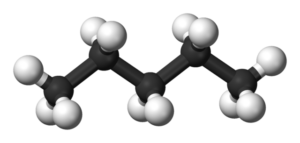Playlist
Show Playlist
Hide Playlist
Addition Reactions – Alkynes and Alkenes
-
Slides Alkanes and Alkenes.pdf
-
Download Lecture Overview
00:01 Hydrogen halides addition We covered this briefly in the context of alkenes. It is also possible to add, for example, hydrobromic acid over a triple bond. If we look at this equilibrium equation here, we can see what’s happening. Either we get protonation of one carbon or we get protonation of the neighboring carbon. Note that in this scenario, what we are trying to do is generate the carbocation which is the most stable. 00:34 This means that on protonation of one of those carbons with the electrons moving from the triple bond to the H+, we generate the carbocation which is most stable which is that, which is the most substituted in the center. We can see this because the compound which is formed is the 2 bromoalkene, not the 1 bromoalkene. It’s also possible to add halogens themselves over the tops of double bonds, as shown in the lower part of the screen. 01:05 As you can see, it’s possible to, therefore, generate a dibromoalkene which can further be brominated again as an alkene to give you a tetra bromoalkene, shown in the bottom of the screen there. It’s also possible to reduce an alkyne down to an alkene. We’ve seen this before when we reduced an alkene down to an alkane in the presence of H2. But, the problem we’ve seen, and we go back to Module I here, is the stereochemistry because it is possible to generate two geometrical isomers, the cis and the trans alkene. Note the difference between the two. Cis, which is the first one we observe in the middle of the board, where the two alkyl groups shown as R and R prime are on the same side and of course, where they are on in the trans position, where they are on opposite sides of the double bond. Now, were this a single bond, you could merely get a rotation around the central sigma like an orbital. But, of course, as double bonds, you cannot get this rotation. And so, these are geometrically, physically and chemically distinct isomers. To achieve one or the other, there are some basic reactions that you can do. To achieve the cis, H2 in the presence of nickel and platinum, and in the case of achieving the trans, you will see that sodium dissolved in liquid ammonia can achieve a trans geometrical isomer. It should be stressed that cis and trans carry with them other nomenclature. So, for example, the cis relates to being together and in German, you’ll see it sometimes referred to as zusammen or Z. Trans, meaning apart, is sometimes referred to in German by entgegen or E. And so, as a consequence, it’s possible to generate two geometric isomers using different conditions. And the selectivity for one geometric isomer over the other becomes increasingly important as we start to synthesise more complicated molecules.
About the Lecture
The lecture Addition Reactions – Alkynes and Alkenes by Adam Le Gresley, PhD is from the course Organic Chemistry.
Included Quiz Questions
What is the correct name of this compound: CH₃(CH₂)2CH=CHC≡CH?
- Hept-3-en-1-yne
- Heptane-3-en-1yne
- Hept-4-en-6-yne
- Hept-1-yne-3-en
- Heptane-1-yne-3-en
What will be the product of electrophilic addition reaction of 1-butyne with HCl?
- 2-Chlorobutene
- 1-Chlorobutene
- 1,2-Dichlorobutene
- Butene
- 1,1,2,2-Tetrachlorobutane
The reduction reaction of 2-pentyne in the presence of Ni or Pt-based Lindlar's catalyst yields…?
- …cis-isomer of 2-pentene.
- …trans-isomer of 2-pentene
- …mixture of cis-and trans-isomers of 2-pentene.
- …pentane.
- …mixture of cis- and trans-isomers of 2-pentene along with pentane.
A chemist wants to reduce 2-hexyne into trans-2-hexene. What should be added to the reaction mixture?
- Na dissolved in liquid ammonia
- H₂ in the presence of Ni or Pt
- Sodium
- Liquid ammonia
- H₂ in the presence of halogen
The cis-trans isomerization phenomenon will be exhibited by…?
- …CH₃-CH=CH-C₃H₇.
- …CH₃-CH₂-CH=CH₂.
- …(CH3)2C=C(CH₃)₂.
- …CH₃-CH=CH₂.
- …CH₂=CH₂.
An alkene with two different substituents displays the cis-trans isomerization phenomenon due to…
- …restricted rotation of double bond.
- …distinct chemical properties.
- …distinct physical properties.
- …presence of two different alkyl groups on the same carbon.
- …distinct chemical properties of different alkyl groups.
Customer reviews
5,0 of 5 stars
| 5 Stars |
|
5 |
| 4 Stars |
|
0 |
| 3 Stars |
|
0 |
| 2 Stars |
|
0 |
| 1 Star |
|
0 |




